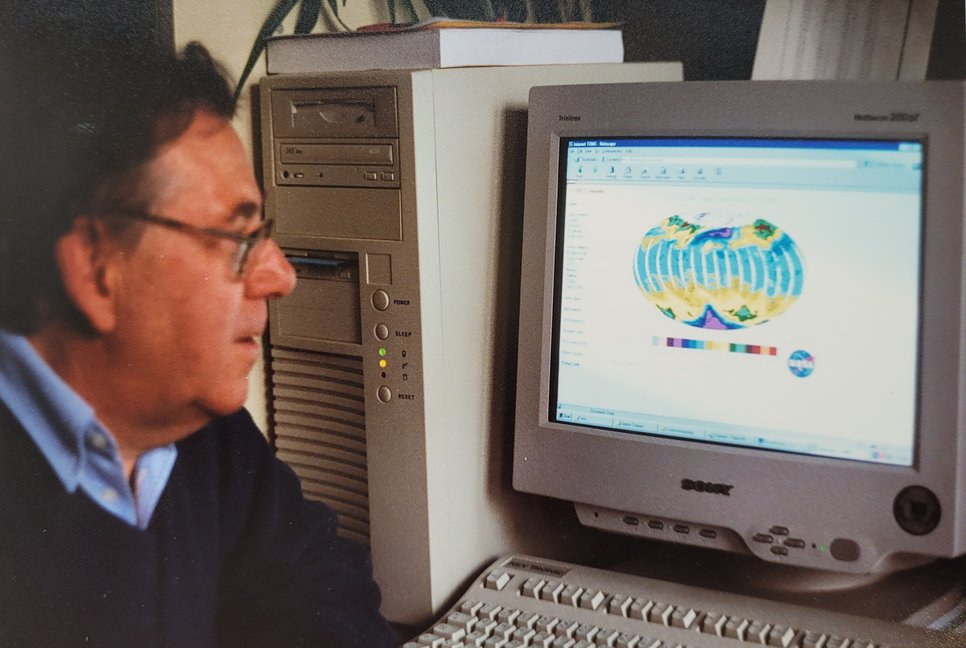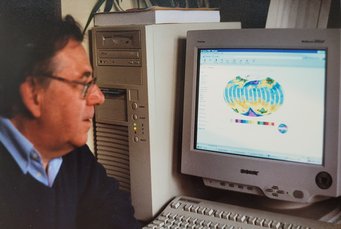The Anthropocene
Text published by Paul J. Crutzen and Eugene F. Stoermer in:
Global Change Newsletter, 41 (May 2000): 17-18.
(only in english) Auszug aus dem IGBP Newsletter 41, May 2000

The name Holocene (´Recent Whole') for the post-glacial geological epoch of the past ten to twelve thousand years seems to have been proposed for the first time by Sir Charles Lyell in 1833, and adopted by the International Geological Congress in Bologna in 1885 (1). During the Holocene mankind's activities gradually grew into a significant geological, morphological force, as recognised early on by a number of scientists. Thus, G.P. Marsh already in 1864 published a book with the title 'Man and Nature', more recently reprinted as 'The Earth as Modified by Human Action- (2). Stoppani in 1873 rated mankind's activities as a 'new telluric force which in power and universality may be compared to the greater forces of earth´ [quoted from Clark (3)]. Stoppani already spoke of the anthropozoic era. Mankind has now inhabited or visited almost all places on Earth; he has even set foot on the moon.
The great Russian geologist VI.Vemadsky (4) in 1926 recognized the increasing power of mankind as part of the biosphere with the following excerpt ´... the direction in which the processes of evolution must proceed, namely towards increasing consciousness and thought, and forms having greater and greater influence on their surroundings'. He, the French Jesuit P. Teilhard de Chardin and E. Le Roy in 1924 coined the term ´noosphere´, the world of thought, to mark the growing role played by mankind's brainpower and technological talents in shaping its own future and environment.
The expansion of mankind, both in numbers and per capita exploitation of Earth's resources has been astounding (5). To give a few examples: During the past 3 centuries human population increased tenfold to 6000 million, accompanied e.g. by a growth in cattle population to 1400 million (6) (about one cow per average size family). Urbanisation has even increased tenfold in the past century. In a few generations mankind is exhausting the fossil fuels that were generated over several hundred million years. The release of S02, globally about 160 Tg/year to the atmosphere by coal and oil burning, is at least two times larger than the sum of all natural emissions, occurring mainly as marine dimethyl-sulfide from the oceans (7); from Vitousek et al. (8) we learn that 30-50% of the land surface has been transformed by human action; more nitrogen is now fixed synthetically and applied as fertilizers in agriculture than fixed naturally in all terrestrial ecosystems; the escape into the atmosphere of NO from fossil fuel and biomass combustion likewise is larger than the natural inputs, giving rise to photochemical ozone ('smog') formation in extensive regions of the world; more than half of all accessible fresh water is used by mankind; human activity has increased the species extinction rate by thousand to ten thousand fold in the tropical rain forests (9) and several climatically important "greenhouse' gases have substantially increased in the atmosphere: CO2 by more than 30% and CH4 by even more than 100%. Furthermore, mankind releases many toxic substances in the environment and even some, the chlorofluorocarbon gases, which are not toxic at all, but which nevertheless have led to the Antarctic 'ozone hole' and which would have destroyed much of the ozone layer if no international regulatory measures to end their production had been taken. Coastal wetlands are also affected by humans, having resulted in the loss of 50% of the world's mangroves. Finally, mechanized human predatim (´fisheries') removes more than 25% of the primary production of the oceans in the upwelling regions and 35% in the temperate continental shelf regions (10). Anthropogenic effects are also well illustrated by the history of biotic communities that leave remains in lake sediments. The effects documented include modification of the geochemical cycle in large freshwater systems and occur in systems remote from primary sources (11-13).
Considering these and many other major and still growing impacts of human activities on earth and atmosphere, and at all, including global, scales, it seems to us more than appropriate to emphasize the central role of mankind in geology and ecology by proposing to use the term 'anthropocene' for the current geological epoch. The impacts of current human activities will continue over long periods. According to a study by Berger and Loutre (14), because of the anthropogenic emissions of C02, climate may depart significantly from natural behaviour over the next 50,000 years.
To assign a more specific date to the onset of the 'anthropocene´ seems somewhat arbitrary, but we propose the latter part of the 18th century, although we are aware that alternative proposals can be made (some may even want to include the entire holocene). However, we choose this date because, during the past two centuries, the global effects of human activities have become clearly noticeable. This is the period when data retrieved from glacial ice cores show the beginning of a growth in the atmospheric concentrations of several 'greenhouse gases´, in particular C02 and CH4 (7). Such a starting date also coincides with James Watt's invention of the steam engine in 1784. About at that time, biotic assemblages in most lakes began to show large changes (11-13).
Without major catastrophes like an enormous volcanic eruption, an unexpected epidemic, a large-scale nuclear war, an asteroid impact, a new ice age, or continued plundering of Earth's resources by partially still primitive technology (the last four dangers can, however, be prevented in a real functioning noosphere) mankind will remain a major geological force for many millennia, maybe millions of years, to come. To develop a world-wide accepted strategy leading to sustainability of ecosystems against human induced stresses will be one of the great future tasks of mankind, requiring intensive research efforts and wise application of the knowledge thus acquired in the noosphere, better known as knowledge or information society. An exciting, but also difficult and daunting task lies ahead of the global research and engineering community to guide mankind towards global, sustainable, environmental management (15).
We thank the many colleagues, especially the members of the IGBP Scientific Committee, for encouraging correspondence and advice.
Paul J. Crutzen
Max-Planck-Institute for Chemistry
Division of Atmospheric Chemistry
P.O. Box 3060
55020 Mainz
GERMANY
Email: air@mpch-mainz.mpg.de
Eugene F. Stoermer
Center for Great Lakes and Aquatic Sciences
University of Michigan
Ann Arbor, Michigan 48109-1090
USA
Referenceces:
1. Encyclopaedia Britannica, Micromedia, IX, (1976).
2. G.P. Marsh, The Earth as Modified by Human Action, Belknap press Harvard University Press, 1965.
3. W.C. Clark, in Sustainable Developement of the Biosphere, W.C.Clark and R.E.Munn, Eds.,(Cambridge University Press, 1986), Chapt.1.
4. V.I. Vernadski, The Biosphere, translated and annotated version from the original of 1926, (Copernicus, Springer, New Yorck, 1998).
5. B.L. Turner II et al., The Earth asTransformed by Human Action, Cambridge University Press, 1990.
6. P.J. Crutzen and T.E. Graedel, in Sustainable Developement of the Biosphere, W.C. Clark and R.E. Munn, Eds.,(Cambridge University Press, 1986). chapt. 9.
7. R.T. Watson, et al., in Climate Change. The IPCC Scientific Assessment J.T.Houghton, G.J. Jenkins and J.J. Ephraums, Eds., (Cambridge University Press, 1990), chapt. 1.
8. P.M. Vitousek et al., Science, 277, 494, (1997).
9. E.O. Wilson, The Diversity of Life, Penguin Books, 1992.
10. D. Pauly and V. Christensen, Nature, 374, 255-257, 1995.
11. E.F. Stoermer and J.P. Smol Eds. The Diatoms: Application for the Environmental and Earth Sciences (Cambridge University Press, Cambridge, 1999).
12. C.L. Schelske and E.F. Stoermer, Science, 173, (1971); D. Verschuren et al. J. Great Lakes Res., 24, (1998).
13. M.S.V. Douglas, J.P. Smol and W. Blake Jr., Science 266 (1994).
14. A. Berger and M.-F. Loutre, C.R. Acad.Sci. Paris, 323, II A, 1-16, 1996.
15. H.J. Schellnhuber, Nature, 402, C19-C23, 1999.
IGBP Newsletter 41, May 2000
